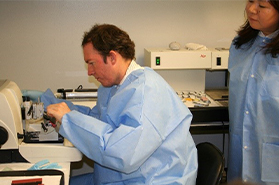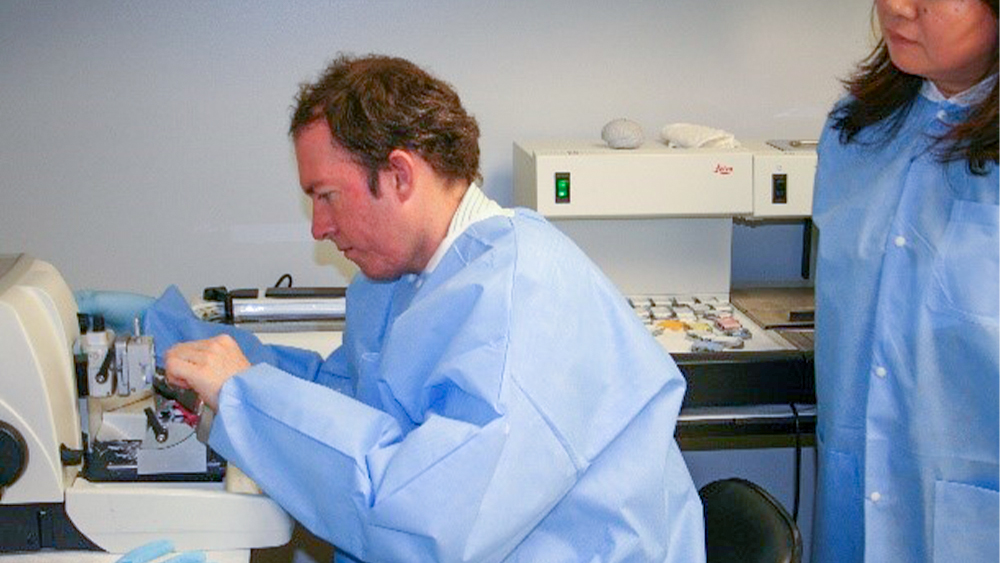Histotechnology is often spoken of as an art and a science. This can also be said in reference to one of the principle components of histotechnology, microtomy. In truth, microtomy extends beyond just art and science to the intangible label of ‘mystery’. Why is it that common training in microtomy suggests taking a smooth, even, stroke of the microtome when sectioning, yet some technicians can use the rapid robo-cutter technique and attain good sections with no compression? How is it that when it is difficult to initiate ribboning, certain troubleshooting attempts such as cooling the block down, hydrating the block, changing blades, etc., may work on one block, but not on others? Why is it that there are times when after repeated attempts to get a good section fail, then suddenly you are able to finally get a good section, and there is no explainable reason for success; it just seemed to happen. There are so many factors working simultaneously when sectioning, and while many times we can isolate the issue and resolve it, there are certainly other times when success remains an unexplainable mystery; a mystery that may not even work on the next block.
Training – The performance of a technologist in microtomy, whether they show good quality or bad quality, good technique or bad technique; this can almost always be traced back to their initial training. While the Histology industry has made tremendous progress in maintaining some degree of formal training programs, and while many Histology jobs have mandatory Board (ASCP) certification requirements, it is unfortunate that an element of on-the-job training exists where new technologists don’t receive the technical guidance and close monitoring necessary to teach and emphasize good technique. There are still some environments where beginning technicians are shown the basic function of the microtome and sectioning, and are then left with a number of practice blocks to figure it out. This unmonitored approach can lead to the development of bad habits and poor technique that stay with the technician throughout their career. Thus, the quality of training strongly influences the end quality of microtomist.

The science of microtomy has taught us that there are critical factors involved in microtomy such as knife angle (see diagram), optimum block or room temperature, etc. Teaching these technical factors is important to take microtomy from an acquired art to a revealed science. Trainees need to understand the theory of microtomy and not just the application if they are ever to learn prompt and effective troubleshooting. Understanding the theory helps streamline our troubleshooting attempts and come to a quick resolution.
Technique – Whether or not science and theory are emphasized during training, every Histology trainee eventually begins to develop their own technique. It is challenging to instructors sometimes to teach the theory of microtomy, demonstrate the steps involved with microtomy, and then see the inevitable frustration that all trainees experience when they struggle to achieve sectioning. It is an acquired skill that usually happens after a series of trial and error failures. Even when the trainee has succeeded in being able to start a ribbon, they must still master the task of producing a smooth, thin, even section without wrinkles, compression, or other artifacts. This is where it is so important in the initial training to have the trainer closely monitoring and guiding the trainee.
This helps reinforce best practices in microtomy technique and give immediate feedback if the trainee begins to deviate from what they have been shown. A good example is the trainer closely observing the trainee as they are facing off the block. The trainer can see if they are going too deep with each gross shaving and are about to chunk or dig into the block. In the image to the right note the close association between the trainer and trainee. As the trainee is sectioning, the trainer is right there offering advice and if necessary, correction. The trainee begins to closely emulate the skill and proficiency of their trainer; all while still developing their own technique.

The development of microtomy technique is another part of the mystery. It would be simple to just direct a trainee to do exactly as you show them, but everyone is different to some degree. Whether it be manual dexterity with their fingers, the size of one person’s hand over another, patience, there will always be something that distinguishes one person’s technique from another. Nonetheless, however we get to it, the common goal that is an absolute mandate is quality, particularly in health care. A colleague of mine once told me their motto as a supervisor that they share with all their employees. It says, “Quality is the signature of your work”. It is your personal stamp. It is an expression of your character and integrity as a medical professional. The two side-by-side images shown here illustrate good and poor quality in biopsy sectioning. The left image shows severe compression, wrinkles, and knife marks. The right image shows smooth, thin uniform sections. The only distinguishing difference between these two ribbons was the technologist and the technique they used. Again, this can all too often be traced back to initial training.


Through comprehensive training and the development of good technique can circumvent problem blocks, facilitate prompt troubleshooting, and in most cases solve the ‘mystery’. However, as unscientific as it sounds, it is still a mystery; but one that the skilled Histologist is committed to solving because there is a patient that still needs to be diagnosed. Part 2 of this series on ‘Microtomy – Science & Mystery’ will focus on troubleshooting. We welcome all readers back on the next issue to discuss various ways to address problematic blocks.
References:
- Brown, S., “Artifacts in Microtomy”, Professional Development Series (Workshop)-Lab Management Consultants, 2018.
- Brown, S., “Supervisory Development Program”, Professional Development Series (Workshop)-Lab Management Consultants, 2019.
- Sheehan, DC, Hrapchak, BB; “Theory & Practice of Histotechnology”, 2nd Edition, Columbus, Ohio, Battelle Press, 1980.

